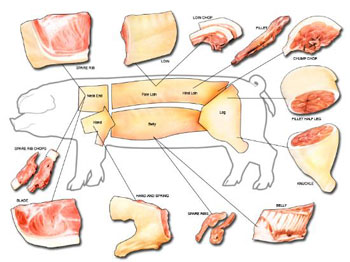 There’s no denying it – I am a pork-man through and through. Though I am not one of these 20 or 30 something dudes with a pig’s head tattooed on his forearm who from time to time is adoringly featured on Food Network, pigs and me go way, way back. Though I am a Jew, blade-cut pork chops, pickled pigs feet, Canadian bacon, rolled pork butt, breakfast sausage and the piece du resistance of my childhood – spare ribs (usually slathered in Duk Sauce – a sugary, vaguely fruity tasting, thin jelly with chunks of plums and something I later learned was ginger, that came in a tall jar with a label featuring a racist caricature of a smiling buck-toothed Chinese man wearing a coolie hat and sporting a queue [the Chinese government abolished the queue in 1911 but it seemingly persisted on labels of Duk Sauce at least through the early 1970’s]) were a staple of my New York childhood.
There’s no denying it – I am a pork-man through and through. Though I am not one of these 20 or 30 something dudes with a pig’s head tattooed on his forearm who from time to time is adoringly featured on Food Network, pigs and me go way, way back. Though I am a Jew, blade-cut pork chops, pickled pigs feet, Canadian bacon, rolled pork butt, breakfast sausage and the piece du resistance of my childhood – spare ribs (usually slathered in Duk Sauce – a sugary, vaguely fruity tasting, thin jelly with chunks of plums and something I later learned was ginger, that came in a tall jar with a label featuring a racist caricature of a smiling buck-toothed Chinese man wearing a coolie hat and sporting a queue [the Chinese government abolished the queue in 1911 but it seemingly persisted on labels of Duk Sauce at least through the early 1970’s]) were a staple of my New York childhood.
I carried on my affair with pigs when I went to the pork bastion, North Carolina, for law school. One Saturday in the fall of 1974, I was invited to a ‘pig pickin’ in Chatham County, outside of Chapel Hill. I arrived early in the day, fascinated by the prospect of actually witnessing the roasting of a whole hog – a feat that had fascinated me since my mother told me the story about how the Chinese created roast pork: Many thousands of years ago there was this Chinese farmer whose barn burned down. Unfortunately, he was not able to save his beloved pigs so the morning after the inferno, he went to survey to what was left and was overwhelmed by the delicious scent. He bent down between the still warm embers of his barn and pulled a piece of charred meat off of one of his now roasted pigs and voila – roast pork.
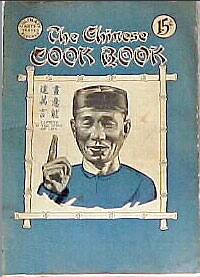 Now of course at 7 years old I did not possess the critical thinking skills I later learned in law school to ask two obvious questions: first why did he keep pigs if not for eating and secondly, ‘did the farmer eat the pork plain or with duk sauce?’ Lest you think a yiddisha momma from the Bronx could not possibly know anything about the history of roast pork, about 15 years ago I was in a used bookstore in San Francisco and found a blue paperback entitled, The Chinese Cookbook by Mr. M. Sing Au published in 1936. The introduction, “A Dissertation on Roast Pig,” recounts the story of Bo-bo, the dumb son of Ho-ti, who accidentally burned down the family’s cottage because he liked to play with fire. Going through the rubble, he “stooped down to feel the pig to see if there were any signs of life in it.” In doing so Bobo burned his fingers; to relieve the pain, ”he put his fingers in his mouth and for the first time in his life (in the world’s life indeed for before him no man had known it) he tasted- crackling…the pig tasted so delicious that he fell to tearing up whole handfuls of the scorched skin with the flesh next to it and was cramming it down his throat in [a] beastly fashion.”
Now of course at 7 years old I did not possess the critical thinking skills I later learned in law school to ask two obvious questions: first why did he keep pigs if not for eating and secondly, ‘did the farmer eat the pork plain or with duk sauce?’ Lest you think a yiddisha momma from the Bronx could not possibly know anything about the history of roast pork, about 15 years ago I was in a used bookstore in San Francisco and found a blue paperback entitled, The Chinese Cookbook by Mr. M. Sing Au published in 1936. The introduction, “A Dissertation on Roast Pig,” recounts the story of Bo-bo, the dumb son of Ho-ti, who accidentally burned down the family’s cottage because he liked to play with fire. Going through the rubble, he “stooped down to feel the pig to see if there were any signs of life in it.” In doing so Bobo burned his fingers; to relieve the pain, ”he put his fingers in his mouth and for the first time in his life (in the world’s life indeed for before him no man had known it) he tasted- crackling…the pig tasted so delicious that he fell to tearing up whole handfuls of the scorched skin with the flesh next to it and was cramming it down his throat in [a] beastly fashion.”
 Sitting on a half-cut log next to a 250-pound pig suspended on a metal grate was a balding man about 70 years old lost in a cloud of pungent hickory wood smoke. He was sipping whiskey from a paper cup and moving coals around with a long metal rod. I sat down on the ground next to him but didn’t say anything for about 10 minutes. Then I asked how long the pig had been cooking - the same first question people routinely ask me at pig roasts. He said he had put it on around midnight but that was just a guess. I sat for the next 6 hours or so just watching him methodically move the coals around – more coals around the hams than the shoulders because of the thicker meat, less along the rib cage. Every so often he’d dip his hand in a bucket of water and with a few flicks of his hand put out the little flare-ups caused by the dripping fat. (I tried the flicking method on my first pig but gave it up in favor of a sprtiz bottle which had the obvious advantage of protecting my hands from burning.) He said very little to anyone during those hours but then at about 4 o’clock or so, he got up looked at me and said, “You know how to use a knife?” I nodded. Then he looked over his shoulder to several men drinking beer and made a movement with his head beckoning them to come over. As each approached, they put on thick leather work gloves. Along with the pigman, they crouched down, picked up the iron grate and brought it over to a large wooden table whereupon they formed a sort of dissection assembly line.
Sitting on a half-cut log next to a 250-pound pig suspended on a metal grate was a balding man about 70 years old lost in a cloud of pungent hickory wood smoke. He was sipping whiskey from a paper cup and moving coals around with a long metal rod. I sat down on the ground next to him but didn’t say anything for about 10 minutes. Then I asked how long the pig had been cooking - the same first question people routinely ask me at pig roasts. He said he had put it on around midnight but that was just a guess. I sat for the next 6 hours or so just watching him methodically move the coals around – more coals around the hams than the shoulders because of the thicker meat, less along the rib cage. Every so often he’d dip his hand in a bucket of water and with a few flicks of his hand put out the little flare-ups caused by the dripping fat. (I tried the flicking method on my first pig but gave it up in favor of a sprtiz bottle which had the obvious advantage of protecting my hands from burning.) He said very little to anyone during those hours but then at about 4 o’clock or so, he got up looked at me and said, “You know how to use a knife?” I nodded. Then he looked over his shoulder to several men drinking beer and made a movement with his head beckoning them to come over. As each approached, they put on thick leather work gloves. Along with the pigman, they crouched down, picked up the iron grate and brought it over to a large wooden table whereupon they formed a sort of dissection assembly line.
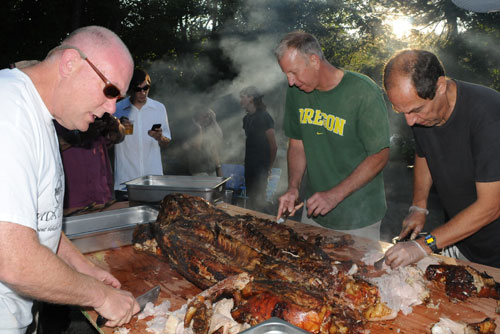 Working with a long, curved razor sharp knife the old timer and two other guys cut away huge glistening chunks of leg, shoulder and loin meat that were then carried down the line to two other guys who began to chop up the meat with cleavers. (My job was to scrape the meat off the bones to insure maximum pig extraction.) The choppers then put down their knives and began further shredding the meat using two dinner forks. The chopped pork was then placed in what best can be described as a long, shallow metal trough. Then the pigman began methodically mixing into the meat a concoction of apple-cider vinegar, pepper and other seasonings. Some minutes later he reached down deep into the Vesuivian hill of shredded pork, pulled out a brown, peppery glazed morsel, held it up to the light, and then popped it into his mouth. “Let’s eat, ” he announced and that’s what over 100 people exactly did.
Working with a long, curved razor sharp knife the old timer and two other guys cut away huge glistening chunks of leg, shoulder and loin meat that were then carried down the line to two other guys who began to chop up the meat with cleavers. (My job was to scrape the meat off the bones to insure maximum pig extraction.) The choppers then put down their knives and began further shredding the meat using two dinner forks. The chopped pork was then placed in what best can be described as a long, shallow metal trough. Then the pigman began methodically mixing into the meat a concoction of apple-cider vinegar, pepper and other seasonings. Some minutes later he reached down deep into the Vesuivian hill of shredded pork, pulled out a brown, peppery glazed morsel, held it up to the light, and then popped it into his mouth. “Let’s eat, ” he announced and that’s what over 100 people exactly did.
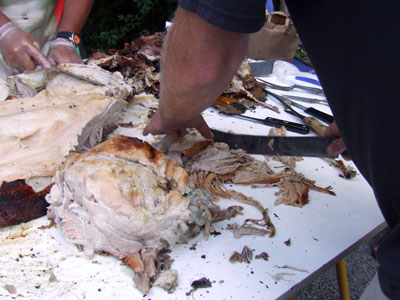 I was transfixed by the experience. A few weeks later I called the pigman and told him I wanted to cook a pig. He graciously gave me the name of the farmer and told me that if I slaughtered the pig myself I’d save money. I told him I didn’t know how to do it. From what I recall he said something like, you graduated from college, got into law school and you can’t slaughter a pig? What kind of education you get boy?” He let out a good laugh and told me to meet him at his friend’s farm three weeks later.
I was transfixed by the experience. A few weeks later I called the pigman and told him I wanted to cook a pig. He graciously gave me the name of the farmer and told me that if I slaughtered the pig myself I’d save money. I told him I didn’t know how to do it. From what I recall he said something like, you graduated from college, got into law school and you can’t slaughter a pig? What kind of education you get boy?” He let out a good laugh and told me to meet him at his friend’s farm three weeks later.
Slaughtering and dressing the hog was, to say the least, a learning experience – it made me wish I paid more attention in high school biology. Shooting the pig in the forehead with a .22 rifle was not the hard part, nor was slitting its belly and yanking out the ‘innards.’ No far and away the most difficult job, was removing the bristly hair. Buckets of scalding water are first poured all over the skin and then with a sharp knife you give the pig the ultimate shave.
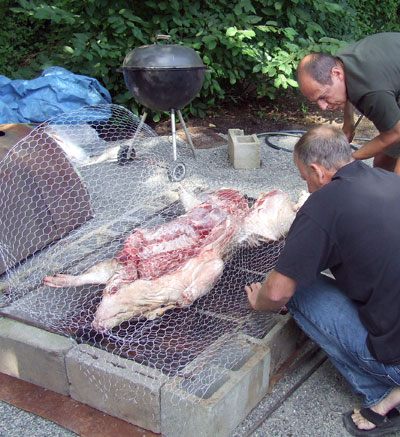 Over the next few years, I was able to support myself roasting whole hogs (and running a Chinese catering business.) It was a continuing learning experience because each pig cooked slightly differently based upon its fat content. The worst mistake that I quickly learned a pig cooker can make is not paying attention to the dripping fat. If the fat – especially around the hams – begins to drip too fast, you just don’t get a flare-up on the coals – you get a first-rate firestorm. What happens is that the dripping river of fat itself ignites and works its way up to the pig’s skin – a veritable lardo-dynamite fuse. One of two things happens at this point (and it happens with lightening speed): fire either engulfs the surface of the pig or if the fire works itself into an air pocket under the pig’s crackled skin (left by the melting fat) that part of the pig literally explodes. Another mistake I made – but only once – was thinking I could drink a half-bottle of Jack Daniels and maintain the focus and concentration necessary to cook a 200-pound pig. While that mistake did not result in a conflagration, it did result in sashimi-style pork – which does not possess a very appetizing flavor profile.
Over the next few years, I was able to support myself roasting whole hogs (and running a Chinese catering business.) It was a continuing learning experience because each pig cooked slightly differently based upon its fat content. The worst mistake that I quickly learned a pig cooker can make is not paying attention to the dripping fat. If the fat – especially around the hams – begins to drip too fast, you just don’t get a flare-up on the coals – you get a first-rate firestorm. What happens is that the dripping river of fat itself ignites and works its way up to the pig’s skin – a veritable lardo-dynamite fuse. One of two things happens at this point (and it happens with lightening speed): fire either engulfs the surface of the pig or if the fire works itself into an air pocket under the pig’s crackled skin (left by the melting fat) that part of the pig literally explodes. Another mistake I made – but only once – was thinking I could drink a half-bottle of Jack Daniels and maintain the focus and concentration necessary to cook a 200-pound pig. While that mistake did not result in a conflagration, it did result in sashimi-style pork – which does not possess a very appetizing flavor profile.
After I left North Carolina in 1978, I went to work as a juvenile rights lawyer in West Virginia where I continued to cook pigs – for pleasure not profit. Far and away, my most memorable pig cooking experience was a birthday party I cooked in Morgantown for the daughter of my good friend Salvatore. Sal and his brother Americo, who came from Monte di Procida near Naples, ran Scotto’s Pizza. They had arrived in the US a few years earlier and ran several pizza joints around the east coast. These guys cooked the real deal – thin crust pizza perfection – the place was an oasis in an otherwise barren culinary wasteland. For Gemma’s first birthday, Sal asked me to cook a pig – but not outside as was my normal practice. No he wanted to close his place on a Sunday afternoon and have me cook it in one of the pizza ovens on two huge roasting pans. Lest you think a 200 pound pig fits in a pizza oven, it doesn’t - but a 75 pound suckling fits just right. Americo, Sal’s younger brother told me he would take care of getting the pig – I would just have to cook it.
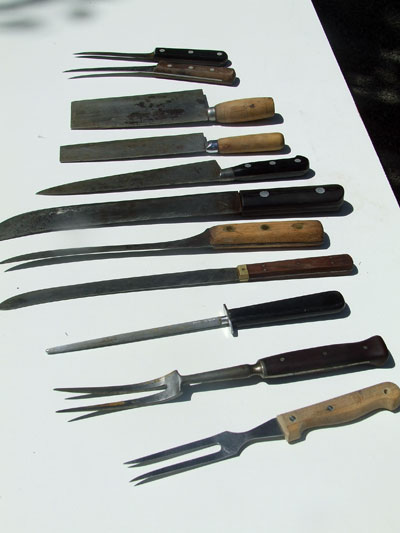 I arrived at 7 a.m. and found Sal cooking my favorite dish, melanzane alla parmigiana. “Sal, where’s Americo?” “In the basement, he’s waiting for you,” Sal said as he cut long slices of eggplant. I walked down the long wooden stairs and there was Americo standing over a wine barrel. “Americo, where’s the pig – in the walk-in? I need to spice it and get it in the oven.” He gestured with his index finger to walk over to the barrel. “You’re fucking kidding me, Americo, right?” I said looking down.
I arrived at 7 a.m. and found Sal cooking my favorite dish, melanzane alla parmigiana. “Sal, where’s Americo?” “In the basement, he’s waiting for you,” Sal said as he cut long slices of eggplant. I walked down the long wooden stairs and there was Americo standing over a wine barrel. “Americo, where’s the pig – in the walk-in? I need to spice it and get it in the oven.” He gestured with his index finger to walk over to the barrel. “You’re fucking kidding me, Americo, right?” I said looking down.
There in the bottom of the barrel, amidst torn pieces of lettuce, sliced tomatoes and pig shit (a natural by-product of pigs – yes even those fancy locally sourced pigs that sell for 12.5 million dollars a pound because they are raised with dignity and love – still shit – a lot) was a piglet running around in very small circles squealing a tune of impending doom.
After he stopped laughing and wiped the tears from his eyes, he said, “It’s simple – you lift the pig up, hold its neck back and I will cut it.” He pulled his folding knife from his pocket and then with a twinkle in his eye said. “The blood – I will catch it in this bowl and make sausage while you cook the piggy. You will like.” “Can’t we just take out in the woods and shoot it in the head with your .38? - quick and easy.” (It should be noted that Americo is the only person in US history who hunted deer with a snub-nose .38 – he never killed one, but really enjoyed walking around the hills of West Virginia.) He shook his head no and told me that the sausage he was going to make wouldn’t taste good if we killed the pig that way.
Though the pig was not heavy, it certainly was not easy to lift out of the barrel and hold steady. Each time I thought I had it in the right position, it squirmed away. Finally, I got the right grip around its flailing legs and with one quick surgical cut – Americo had obviously done this many times before – the pig was dispatched. After the pig was duly bled out, we proceeded to gut it, saving the intestines, liver and kidneys for assorted side dishes that Sal’s wife would later make. We then scalded the pig’s skin and shaved it – a much easier job than what was required for a 250-pound hog.
I split the carcass open and rubbed the inside with olive oil, vinegar, oregano, basil, pepper, fennel seed and salt – my interpretation of an Italian pig rub. The Bari pizza oven cooked that suckling pig to perfection in 3 hours – but for the next few weeks the pizzas and calzones that came out of it tasted like – yeah you guessed it.
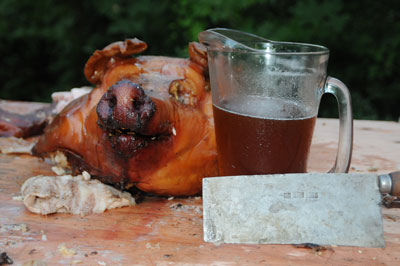 During this past summer the NY Times Wednesday food section (far and away my favorite section of the paper) ran a piece about a newbie Brooklynite’s (I say ‘newbie’ because the Brooklyn I knew growing up in NY in the 1950’s and 60’s is as everyone knows, not the Brooklyn of today) hog cooking journey. The piece was informative though was permeated with a slight aire of cuteness. However, please, please, should you actually ever want to cook a pig yourself, I implore you, do not cook it under ground as the article’s author did. While this method employs the classic and well-respected Pacific Island preparation of building a big-ass fire, dumping on rocks (hopefully of the non-exploding variety), wrapping the pig in layers of burlap or banana leaves and burying it for hours, the end result is essentially BOILED pig. The pig steams underground resulting in the vaporization of most of its vital juices. I don’t mean to offend anyone by this criticism but after eating meat from scores of pigs over the last 35 years, an above-ground pig is simply the only way to go. If you want details, email me at This email address is being protected from spambots. You need JavaScript enabled to view it. .
During this past summer the NY Times Wednesday food section (far and away my favorite section of the paper) ran a piece about a newbie Brooklynite’s (I say ‘newbie’ because the Brooklyn I knew growing up in NY in the 1950’s and 60’s is as everyone knows, not the Brooklyn of today) hog cooking journey. The piece was informative though was permeated with a slight aire of cuteness. However, please, please, should you actually ever want to cook a pig yourself, I implore you, do not cook it under ground as the article’s author did. While this method employs the classic and well-respected Pacific Island preparation of building a big-ass fire, dumping on rocks (hopefully of the non-exploding variety), wrapping the pig in layers of burlap or banana leaves and burying it for hours, the end result is essentially BOILED pig. The pig steams underground resulting in the vaporization of most of its vital juices. I don’t mean to offend anyone by this criticism but after eating meat from scores of pigs over the last 35 years, an above-ground pig is simply the only way to go. If you want details, email me at This email address is being protected from spambots. You need JavaScript enabled to view it. .
It heartens me to see the porcine renaissance that has swept the country over the last few years. Restaurants curing their own hams and guanciale, fusion barbecue joints and multi-course pork meals are good for the nation’s soul – though I do wish that all those hipster chefs would offer more on their menus than the now ubiquitous roasted pork belly.
Paul Mones is nationally recognized children's rights attorney specializing in representing sexual abuse victims and teens who kill their parents. He is also a published author and most importantly an avid chef who won the 1978 North Carolina Pork Barbecue Championship.

